Prospects of Treating Ocular Hypertension and Glaucoma with Peptidic and Non-Peptide Kinin Mimetic Drugs
Najam A Sharif*
Department of pharmaceutical sciences,college of pharmacy of health sciences, Texas Southern University (TSU), USA
Submission: January 24, 2017; Published: May 04, 2017
*Corresponding author: Naj Sharif, PhD, FARVO, FBPhS, Department of Pharmacology, School of Pharmaceutical Sciences, TSU University, Executive Director in Global R&D, Head, Global Alliances & External Research, Santen Inc., 6401 Hollis St., Suite 125, Emeryville, CA 94608, USA, Tel: 415-268-9181; Email: naji333sha@yahoo.com
How to cite this article: Sharif N.A. Prospects of Treating Ocular Hypertension and Glaucoma with Peptidic and Non-Peptide Kinin Mimetic Drugs. JOJ Ophthal. 2017; 3(1): 555601. DOI: 10.19080/JOJO.2017.03.555601
Abstract
The endogenously generated small nonapeptide bradykinin (BK) is often associated with inflammation, edema and pain amongst many other functions and pathologies. However, the latter aspects pertain to locally produced BK from circulating plasma precursor polypeptide kinninogen (KNGN). Recent work in ocular tissues and cells have a revealed a novel local synthesis of BK and other kinins from tissue-derived KNGN via action of kallikrien enzymes, quite independent from the blood-derived polypeptide. Furthermore, the whole kininergic system machinery including local KNGN, kallikrein enzymes to generate kinins from KNGN, two sub-types of kinin receptors (Bj-and B2-receptors), and the complete signal transduction pathways coupled to these receptors have been mapped out. Additional work has highlighted a number of downstream signaling and other biological responses that ensue following activation of Ba- and B2 receptors in human ocular cells and tissues. One key aspect to be discussed in detail in this review is the novel finding that BK, peptidergic BK analogs, and especially non-peptide mimetics of kinins (e.g. FR-199097; BKA78), profoundly lower and control intraocular pressure in a number of species, including ocular hypertensive (OHT) monkeys. These novel observations strongly suggest that kinin agonists represent a novel class of ocular hypotensive agents that could be of immense value in treating OHT associated with primary open-angle glaucoma (POAG) and perhaps other forms of glaucoma.
Ocular Hypertension Associated with Glaucoma
At a simplistic level, our knowledge has advanced to a point where it is now clear that elevated intraocular pressure (IOP) results from a fundamental imbalance between the generation of aqueous humor by the ciliary body and its efflux from the anterior chamber of the eye via one of two pathways [1-3]. The most physiologically relevant mechanism of AQH drainage involves the IOP-dependent outflow via the trabecular mesh work (TM) and Schlemm's canal (SC) route [1-3]. The lesser utilized pathways under normal conditions are the uveoscleral [1-3] and ocular lymphatic [4] pathways, but the latter can be engaged by certain drugs such as FP-class prostaglandin analogs (FPGAs) like latanoprost and tafluprost [1-6]. The chronically increased IOP, a condition generally termed as ocular hypertension (OHT), caused by blockage of the AQH drainage TM/SC pathways [7] during the aging process or due to ocular inflammation and deposition of various debris, along with apoptotic death of retinal ganglion cells. can lead to a clinically defined disease called glaucoma [8-10]. This high IOP distressfully distends and traumatizes the whole Whilst, glaucoma is painless and otherwise asymptomatic globe and initiates the death of RGCs and/or breakage of RGC axons at the back of the eye. These elements then cause a retrograde demise of the RGCs leading to severing of nerve fibers connecting the retina to the brain [11-13]. Many deleterious neurotoxic elements (e.g. high levels of extruded glutamate, endothelin, inflammatory cyto-and chemo-kines, noxious gases (e.g. nitric oxide; hydrogen sulfide)) and proteolytic enzymes (e.g. caspases and matrix metalloproteinases) released by activated macrophages [12-19], injured RGCs and interneurons are the culprits responsible for such neurotoxicity/chemically-induced axotomy of the RGCs. Hypoxia and ischemia [20,21] are also involved in the initiation phase of vascular dysfunction-induced death of RGCs since the thinning of the optic nerve at the level of the optic nerve head (ONH) forces the retinal blood vessels attached to the optic nerve to bend thereby restricting blood supply to the retina. While this progressive loss of RGCs occurs over several decades, if OHT is not treated to reduce the IOP the resulting glaucomatous optic neuropathy causes severe visual impairment, reduction of visual acuity and visual field and eventually results in irreversible blindness. Although many forms of glaucoma exist (e.g. open-angle glaucoma; closed-angle glaucoma; exfoliation glaucoma; myopic glaucoma) [8,9,22-26], the most prevalent is primary open-angle glaucoma (POAG) [26-28]. Behind cataracts, POAG is the second leading cause of blindness afflicting several millions of patients. It is estimated that by 2020, the global glaucoma-related blindness will reach ~80 million [26-28]. Elevated IOP and advancing age are the two major risk factors associated with POAG even though genetic factors [26] and race (especially African and Asian heritage) [29], myopia, diabetes and oxidative stress [30-36] and various vascular irregularities and dysfunctions [20,22], and intracranial cerebrospinal pressure [37,38] have been also linked to the development of POAG. The seriousness of POAG is often underestimated since it causes no overt discomfort or pain to the patient and insidiously progresses unnoticed over time. Considerable damage to the retina [33-36] and optic nerve and optic nerve head (ONH) [14,29,39-41] continues unyieldingly leading to scotomatous damage that manifests as loss of peripheral vision followed by a "tunnel vision" syndrome, thereby finally signaling the demise of ~40% of the original million RGCsof the patient and equivalent loss of connections to the brain and visual cortex [8,9,42-45]. Those lost or dying RGCs cannot be resuscitated and their axonal connections revived [46-48], and if left untreated the glaucomatous optic neuropathy due to OHT and oxidative /neurotoxic elements would claim the remaining RGCs causing total blindness [49-53].

Data are mean±SEM uses a [Ca2+]I mobilization assay in cells derived from several different human donors' eyes. h-tNPE cells are SV40-virus- immortalized human non-pigmented ciliary epithelial cells derived from human ciliary epithelium that respond just like normal primary NPE cells. [145,146,157]
A number of treatment options have been developed to deal with POAG-associated OHT including ocular hypotensive medications [1-3,54-56], laser therapy and surgical interventions [57-64]. Unfortunately, as is the case with most drugs and surgical procedures, these treatment modalities have numerous side-effects (e.g. Burning and stinging, foreign- body sensation, brow-ache, ocular surface dryness, pulmonary hypertension and bradycardia, etc.), and adverse complications associated with them [1-3,54,55]. Additionally, poor compliance [65] and adherence to prescribed topical ocularly administrated medications by the OHT POAG patients (due to forget fulness, poor dexterity,lack of symptomatic pain or other cues due to OHT, poor understanding of the treatment regimen, and perhaps due distrust, etc.) contributes to the progression of the disease process. Similarly, laser therapies, although effective at the beginning, lose their efficacy over time [57-62]. Reports have surfaced that indicate that POAG/ OHT is only controlled in ~50% of patients who received laser treatment, and indeed due to scarring,the procedure often needs repeating within one-five years [57-64]. Indeed, such lasering and filtration procedures also have certain risks of complications and adverse events associated with them. Thus, there remains a continued unmet medical need to discover new and improved eye drop- medications and other novel surgical techniques to help the OHT/POAG patients mitigate and treat their underlying glaucomatous optic neuropathy caused by elevated IOP. To this end, a better understanding of the many complex pathways involved in AQH dynamics [4,7-10] has culminated in the discovery and development of many novel targets and ligands [13,54,55] that can modulate IOP via these targets to accomplish a level of homeostasis of AQH production and drainage. In order to address poor patient compliance, a number of innovations leading to sustained drug-release devices (e.g. implants, punctal plugs or contact lenses) [60-64,66-70] have been developed such that the patient need not remember to self-administer the medication. Likewise, a revolutionary set of novel surgical interventions [57-64] with much reduced surgical time and effort required and minimal adverse events and complications are becoming available [57-64]. These include the following: non-penetrating glaucoma surgery (NPGS), non-invasive glaucoma procedure, minimally invasive micro sclerostomy, blebless ab externo glaucoma surgery, ab externo bleb surgery, and the elegant minimally-invasive glaucoma surgery (MIGS) [60-64] that involve insertions of tiny drainage devices into the anterior chamber of the eye that appear to be highly effective in decreasing IOP [62-64]. Time will tell if indeed these innovations become mainstay treatment options for POAG/OHT patients in the near future. Regardless, however, the ordinary patient who is unable to afford the latter surgical procedures and devices, and those patients who are refractory to or cannot tolerate existing medications, will still require new topically administered drugs to lower and control the IOP in order to preserve their vision.

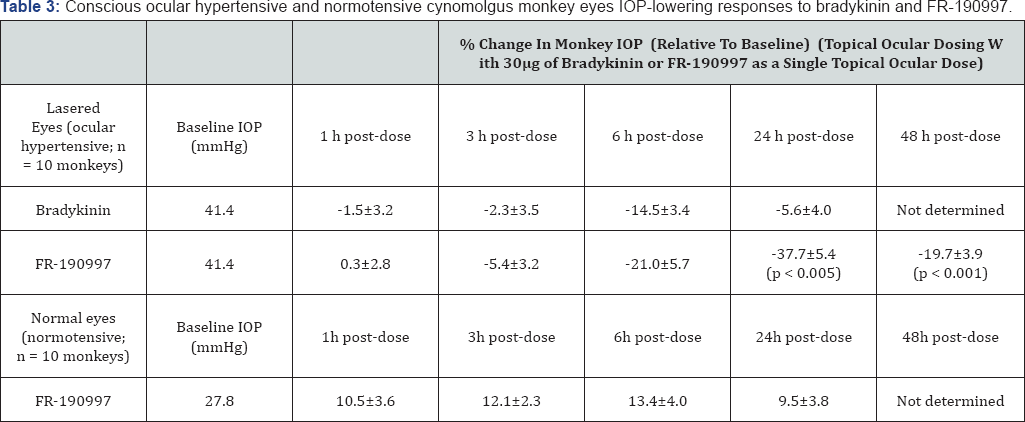
Present Day Pharmacotherapy for OHT
One of the earliest pharmacological agents to be used to lower elevated eye pressure is a muscarinic receptor agonist, pilocarpine [1-3]. It just happened that it promoted egress of AQH through the TM, hence pilocarpine became the first known conventional outflow promoter. Since it strongly constricted the pupil, made accommodation difficult and painful due to brow- ache, and needed to be administered up to 4-times a day, newer drugs with higher efficacy and lesser side-effects were sought and discovered over the next few decades. These included carbonic anhydrase inhibitors such as dorzolamide and brinzolamide, beta-adrenergic antagonists (e.g. timolol; betaxolol) and alpha- adrenoceptor agonists such as brimonidine and para-amino- clonidine [1-3,54,55]. Whilst these drugs lowered IOP well, they required at least twice daily dosing and they primarily inhibited the production of AQH by the ciliary processes of the ciliary body. Eventhough compliance increased and a greater efficacy was achieved, these agents had their own short-comings in terms of side-effects including ocular surface irritation (hyperemia), burning and stinging,allergy and drowsiness (a-agonists), and some pulmonary and cardiac insufficiency (with p-blockers) [13,55] Furthermore, we have learnt that AQH constituents serve important nutritional needs of the tissues inside the anterior chamber of the eye [10], and thus reducing its availability negatively impact the ciliary body, lens, corneal endothelial cells, and may in fact damage the TM and SC endothelial cells. Thus, a major breakthrough in OHT / POAG treatment occurred in the mid-90s when FP-receptor-selective prostaglandin (PG) agonists (PGAs) (e.g. latanoprost; travoprost; bimatoprost; tafluprost; unoprostone isopropyl ester) [3,5,6,71-73] were discovered and introduced into ocular clinical medicine. These PG drugs revolutionized the POAG/OHT treatment paradigm since they required once-daily ocular administration (before bed-time) and were much more potent and efficacious than the existing medications since they created new drainage pathways across the ciliary muscle and sclera (uveoscleral pathway) to help drain the AQH [1-5]. Nevertheless, these novel PGAs had some significant side-effects that included hyperemia, darkening of the iris color and increased pigmentation of the periorbital skin, growth of eye-lashes, deepening of the eye orbit, and in some cases cystoid macular edema [1-5,71-74]. Additionally, some OHT/POAG patients were quite refractory to the PGA drugs such that they required multiple drugs to control their IOPs. Not surprisingly, a multitude of fixed-dose combination products [4,75] containing different dual combinations of various ocular hypotensive drugs (and even a triple combination product) have now become available. However, due to the inherent genetic and biological variation in responses of patients to the different classes of IOP-lowering medications and their relative susceptibility to the side-effects of the drugs, there still remains a great need to hunt for and discover new drugs that are more effective, longer acting, efficacious in majority of OHT patients, and that induce fewer and milder off-target side-effects, thus having a greater therapeutic index than the existing drugs [67,76,77] (Table 3).
Future OHT/POAG Pharmacotherapy
The potential additivity of new pharmacological agents to PGAs in the treatment of OHT and POAG has spurred the recent surge in research for novel agents exhibiting IOP-lowering properties. The realization that POAG is not only caused by elevated IOP since patients with normal IOPs still lose vision [7880], but perhaps is a reflection of enhanced RGC susceptibility to oxidative stress [7-9,12,32-36,42] and apoptotic process [15,47,81-90], has stimulated a renewed interest in finding drugs that have dual or multiplicity of mechanisms of action, including direct potential neuroprotective activity. The latter aspect stems from the finding that agents like betaxolol [91-95] and brimonidine [90,96-99], whilst lowering IOP, also upregulate the release of endogenous neurotrophins [89] in retinal tissues that could heal/rescue some of the RGCs that are compromised from the elevated IOP and oxidative stress. Likewise certain PGAs stimulate blood flow at the ONH in addition to reducing IOP [5,6,100]. Additionally, as the tools to monitor IOP [98,99] have become more accessible at a lower cost and with a greater sensitivity, including round-the-clock monitoring of IOP [99,100], and as new models of OHT/POAG are introduced using various species [48,23-25,101-104], the potential for such innovations to enhance drug discovery have dramatically increased in recent years. The ability to perform AQH dynamic measurements in small laboratory animals like mice [105], and to exploit enucleated and ex-vivo perfused bovine [103,106], porcine [103] and human eye anterior segments, and even whole eye [107], has further accelerated the mechanistic approach to ocular drug discovery and characterization. Accordingly, pharmacological agents that have exhibited ocular hypotensive efficacy in some of these animal/ ex-vivo models include K+- channel openers [108], Na+-K+ -ATPase inhibitor digoxin analogs [109], angiotensin-II receptor antagonists [110,111], renin inhibitors [112], angiotensin converting enzyme (ACE) inhibitors [113-116], ACE-2 activators [117,118], cannabinoids [119], rho- kinase inhibitors [120-122], nitric oxide (NO) donors and their conjugates [123-127], serotonin (5-hydroxy-tryptamine (5-HT)) receptor agonists [103,128,129], hydrogen sulfide donors [130], dopamine receptor agonists [3], melatonin receptor agonists [13], adenosine receptor agonists and antagonists [131], guanylate cyclase activators [123,132], novel EP2 receptor agonists [133,134], dual pharmacophoric PGs encompassing FP and EP3- receptor agonistic properties [135,136], etc. The most recent unexpected discoveries of potential drug candidates for OHT/ POAG treatment pertain to the kallikrein-kinin (KNK) system which will be addressed in detail below (Table 4).
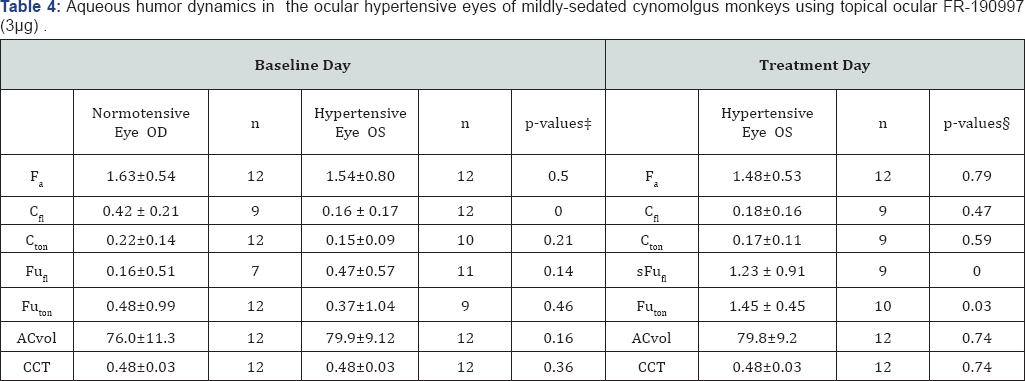
* Values are means±standard deviation. t, comparing hypertensive with contralateral normotensive eyes; �p-values: comparing baseline day with treatment day by Student's two-tailed paired t-test. ACvol, anterior chamber volume, |jl; CCT, central cornea thickness, mm; Cf| fluorophotometric out flow facility, iJl/min/mmHg; Cton, tonographic outflow facility, |j1/min/mmHg; Fa, aqueous flow, |jl/min; FuFI, uveoscleral outflow calculated with Cfl, jl/min; Futon, uveoscleral outflow calculated with Cton jl/min; Times are 30 minutes. FR-190997 (0.01%) was applied as a 30jl drop (total dose of 3jg) to each eye of each monkey Modified from Ref 155.
Kallikrein-Kinin (KNK) System in the Eye
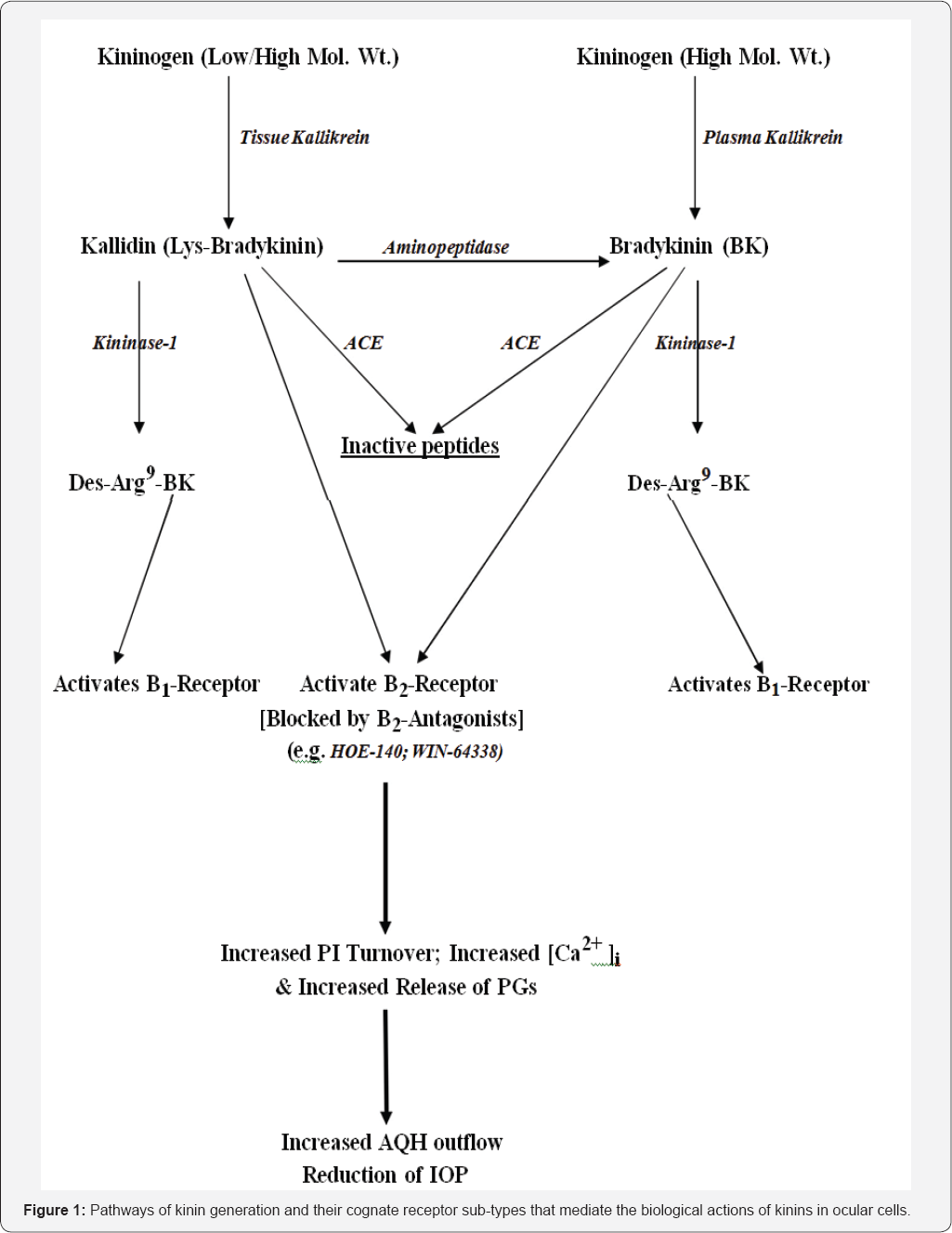
The peptide bradykinin (BK) was discovered many decades ago and the pathway to its generation has since been fully delineated. Today, we know that a precursor polypeptide, kinninogen (KNGN), is cleaved by specific enzymes (kallikreins) to produce a 10-amino acid -and a nine-amino acid containing peptide, Lys-BK and BK respectively [137,138]. Lys-BK is then converted to BK by an aminopeptidase, but both Lys-BK and BK act on the B2-receptor subtype of BK receptors, which is the predominant homeostatic receptor found Under normal physiological situations [137,138]. Kininase-1can convert both Lys-BK and BK to an octapeptide (Des-Arg9-BK) that interacts specifically with B1-receptor subtype of BK receptors which get upregulated during injury, trauma and other deleterious situations [137,138]. ACE inactivates both Lys-BK and BK to small inert peptides (Figures 1, 2). The notoriety surrounding BK and Lys-BK (kallidin) originates from their ability to cause deleterious vasodilation, inflammation, pain and cell proliferation [137,138]. These undesirable effects of kinins have been noted in all parts of the body and either trigger or are manifestations of various underlying diseases ranging from angioedema, diabetes, pulmonary and systemic hypertension, and aneurysms and diabetic retinopathy in the central nervous system and retina [137-139]. It was quite a revelation when various components of the KNK system were found in various compartments of the eye under normal circumstances and associated with cells and tissues of the eye [140,141]. Soon it became clear that BK and perhaps Lys-BK could be formed locally by the actions of tissue-based kallikriens on tissue-derived KNGN thereby creating a paracrine kininergic system within ocular tissues [140,141]. To support this notion further, both B1 and B2-receptor subtypes were found in various ocular cells that were functionally active mediating the actions of BK and related analogs of BK, generating intracellular second messengers [142145] Figure 3 producing further downstream effects such as promoting liberation of PGs [146,147] and causing ocular tissue contraction/ relaxation [148-150], etc. While circulating KNGN and kallikriens in ocular blood vessels do produce BK and Lys- BK to cause the vasodilator and pro-inflammatory effects as in the rest of the body, that system is distinctly different from the tissue-based KNK system in the ocular systems.
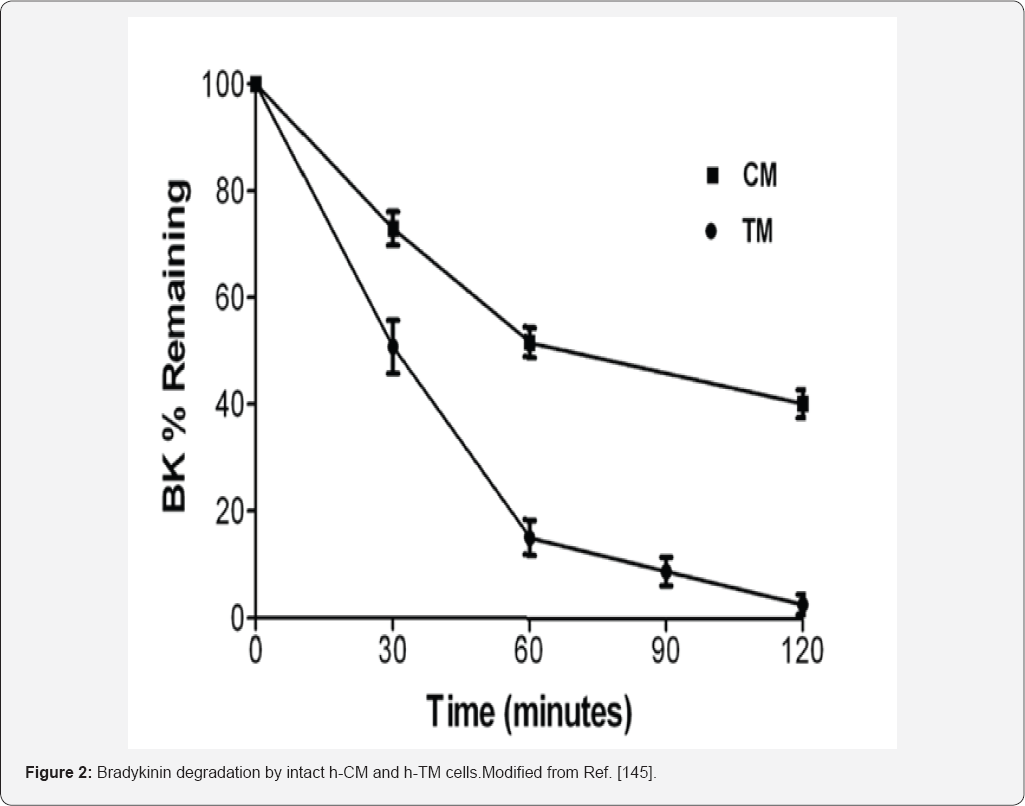

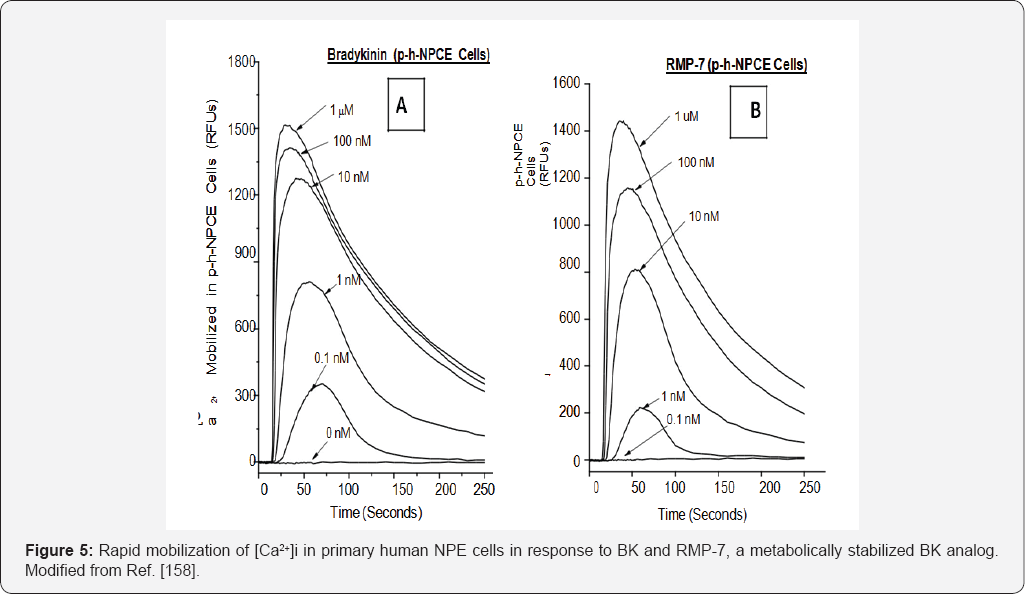
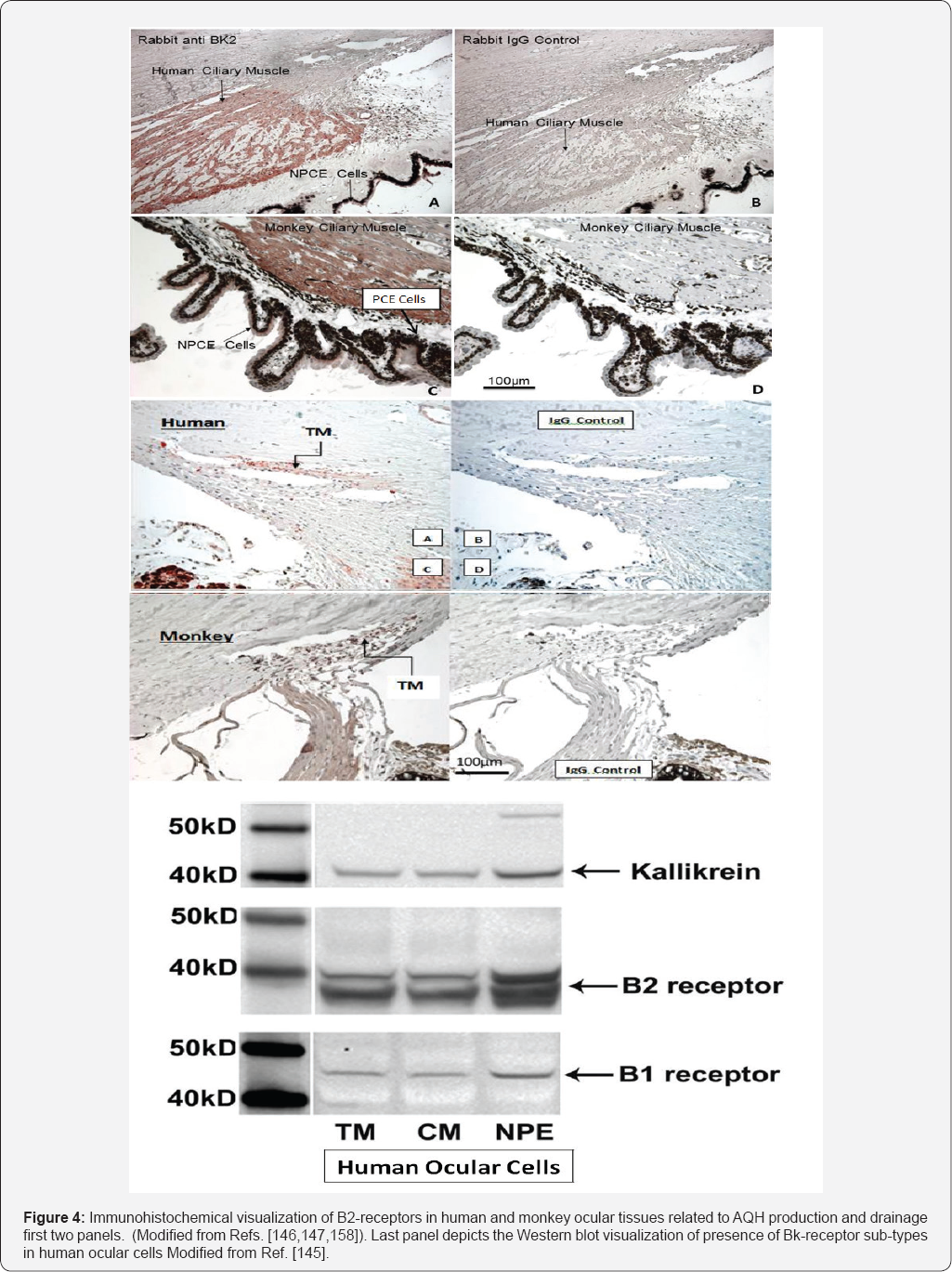
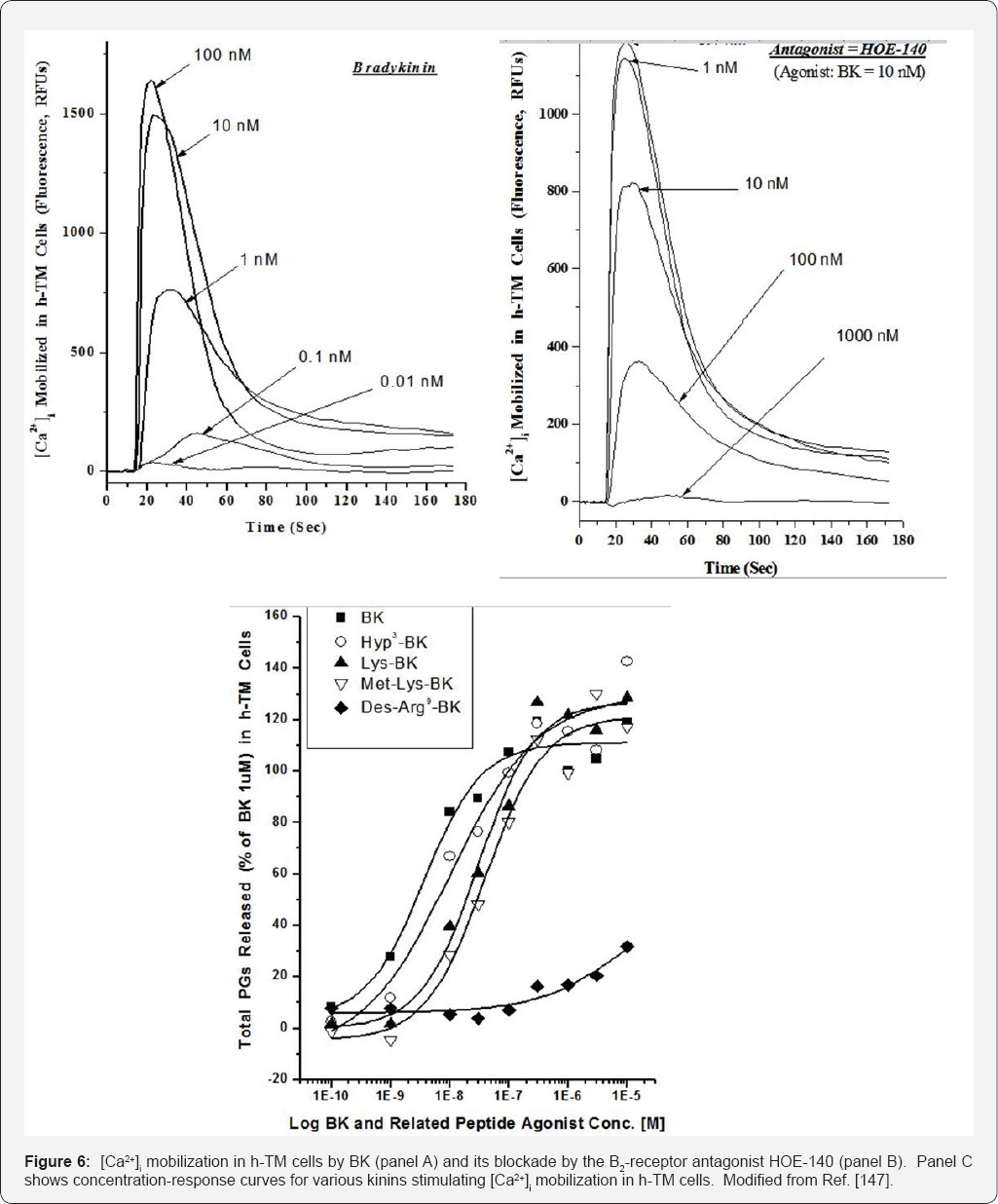

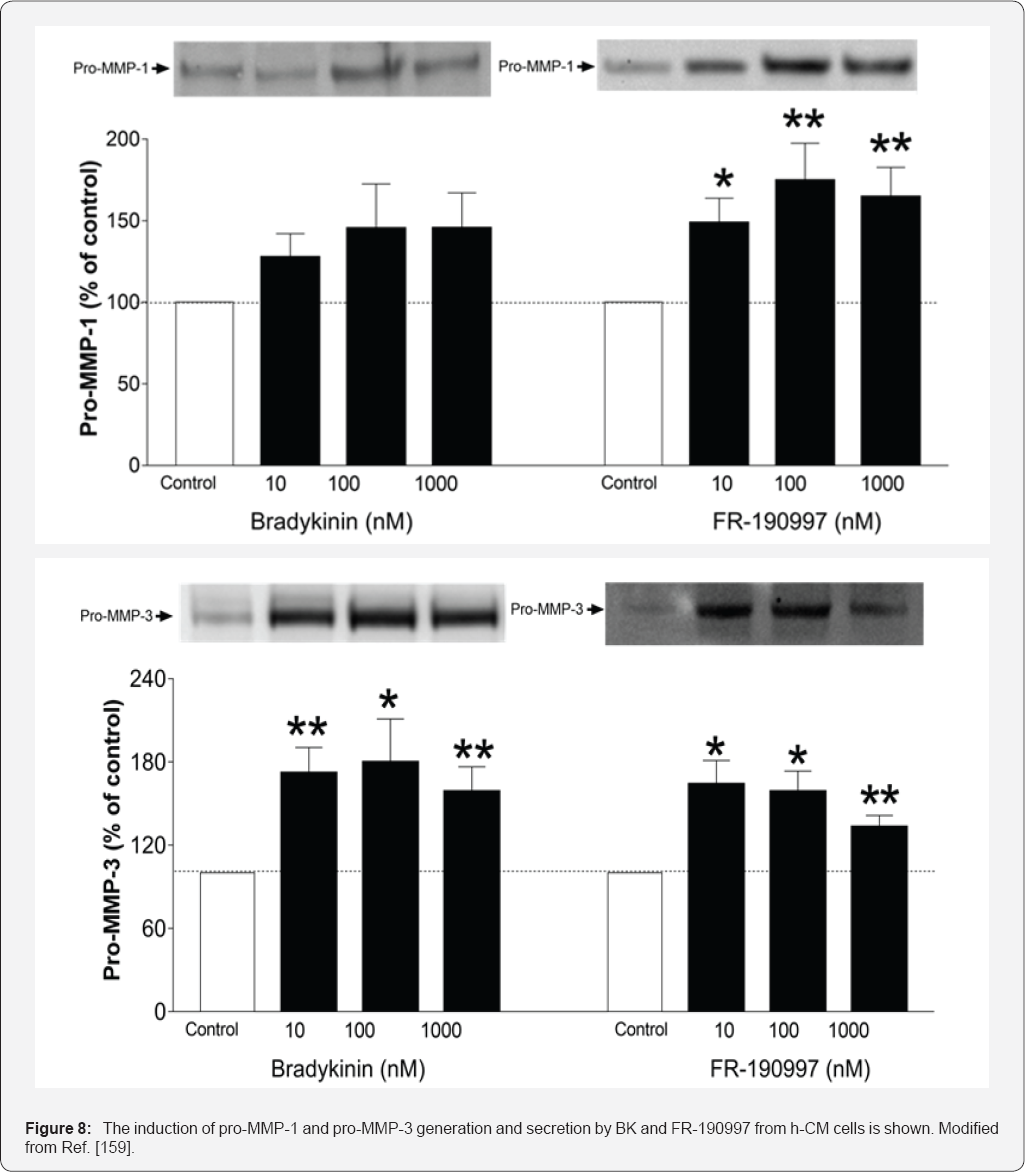
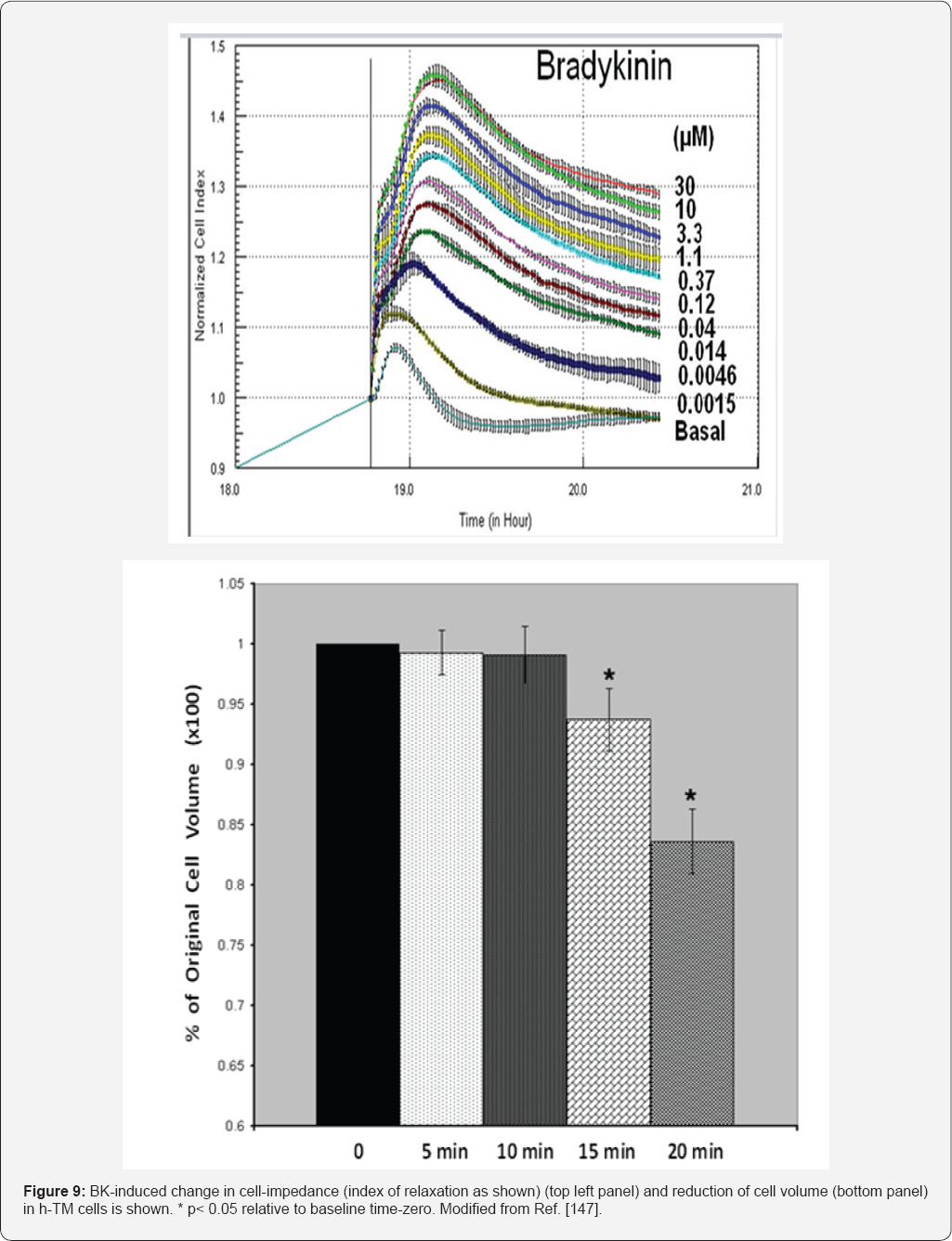
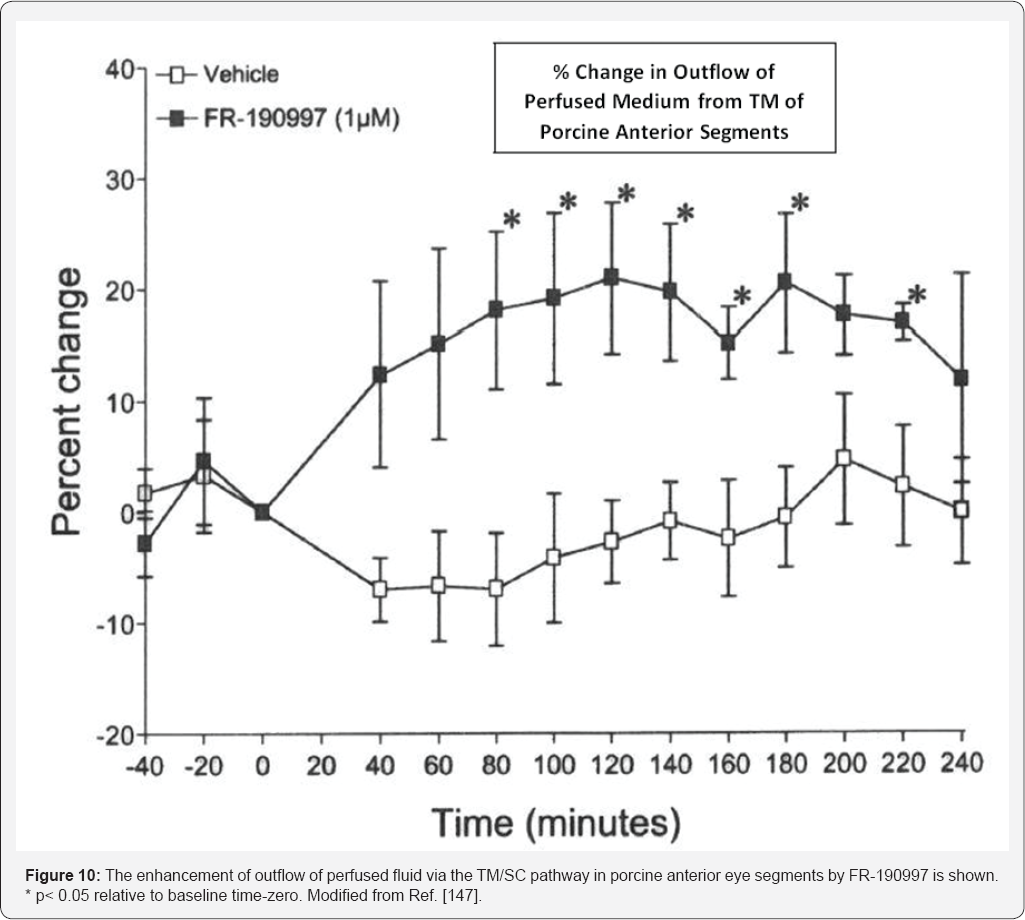
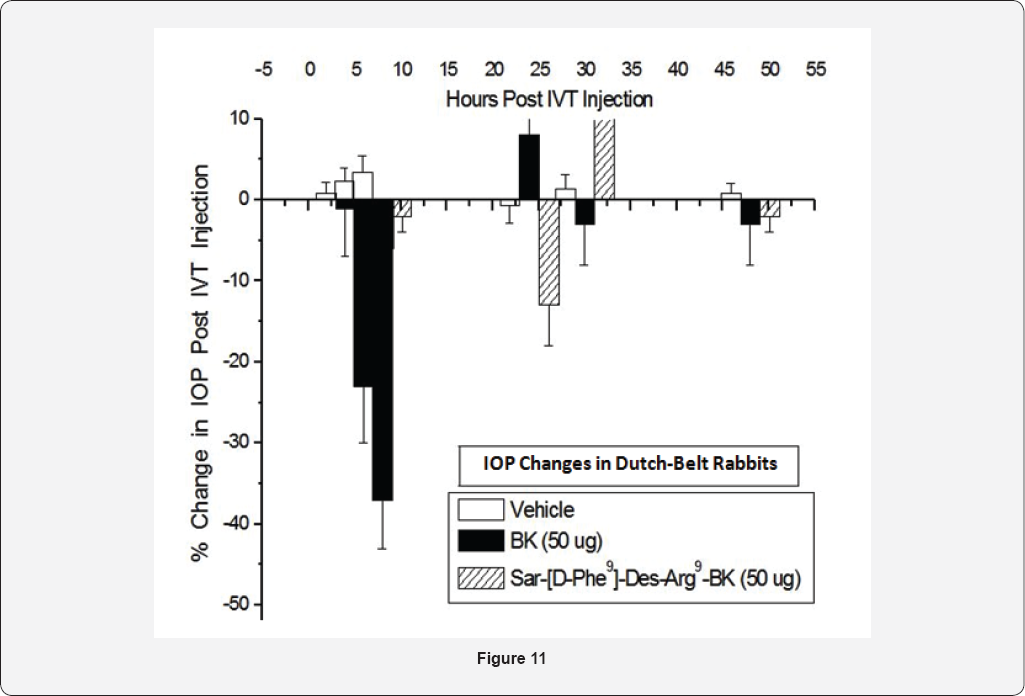
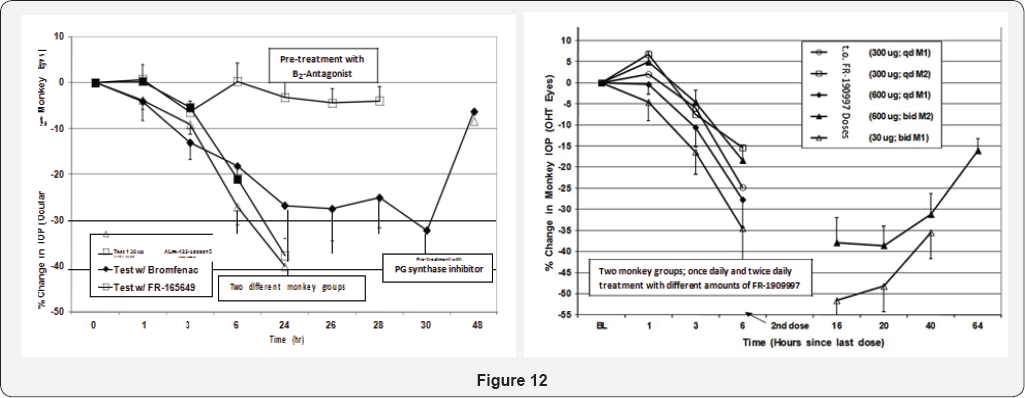
In order to ascribe a role of BK in ocular functions, early researchers administered BK either systemically or topical ocularly (t.o.) or via injections into the anterior chamber of the eye of different species [151-154]. BK either increased or decreased IOP accompanied by local inflammation and/or miosis [148-155].Using ex-vivo isolated bovine [106] and porcine [103,156] eye anterior segments, perfused BK was shown to induce disparate results, either causing decreased outflow or increasing outflow of AQH, thereby adding to the overall confusion. The known metabolic instability of BK in the presence of fluids or exposed tissues/cells [145,157], and possible species differences potentially contributed to these contradictory observations. The need for metabolically stabilized BK analogs or non-peptide BK mimetics was soon realized (see below). The rather paucity of information regarding the ocular BK receptor family in human ocular cells and tissues was slowly overcome by research in the early 80s-90s, including the work oflgic [140], Ma et al. [141], Sharif et al. [142], Wiernas et al. [143,144], and by Webb et al. [106,145,157].
The work of Ma et al. [141] using reverse transcription- polymerase chain reaction (RT-PCR) and Southern blot analyses, and in situ hybridization to localize components of the KNK system in human ocular tissues was affirmed using immunohistochemistry (IHC) [145-147]. For the current subject matter of this review article, it was important to demonstrate the specific distribution and localization of the B2-BK receptor proteins. Accordingly, the presence of B2-BK receptors in human TM [147], ciliary muscle (CM) [146] and non-pigmented ciliary epithelial (NPE) [158] cells was demonstrated by IHC techniques. These are all key tissues involved in the drainage (CM and TM) Figure 4 and production (NPE) of AQH respectively. Importantly, these IHC observations were extended to the cynomolgus monkey anterior chamber tissues [146-148] in order to help correlate functional in vivo data (IOPlowerig; AQH dynamics) with these in vitro observations (see ahead). Next, it was important to determine whether the IHC of B2-receptors bore any linkage to functionality of these proteins in the respective human ocular cells mentioned above. To this end, primary h-NPE, h-CM and h-TM cells were isolated and challenged them with BK, its many peptide analogs and two non-peptide BK-mimetics, FR-190997 and BK2A78. Many of these kininergic compounds stimulated the production of intracellular inositol phosphates [142,156], and all peptide and non-peptide agents liberated endogenous intracellular Ca2+ ((Ca2+)i) from the endoplasmic reticulum in normal h-NPE, h-CM and h-TM cells [146,147,158] Figures 5,7 (and in bovine TM cells [155]) to varying degrees and with different relative potencies, a feature also observed in cells transfected with a cloned human B2-receptor. Additionally, these BK agonists also activated extracellular-regulated kinases-1/2 in h-TM [145] and h-CM [159] cells, and promoted the synthesis and secretion of PGE2 and PGF2a in the latter cells Figure 7. Since Des-Arg9-BK (a selective B1-agonist) was always a very weak agonist in all these biochemical assays, and since two B2-receptor antagonists (H0E-140 and WIN-64338) potently blocked the responses induced by BK, RMP-7 (a stabilized peptide analog of BK), FR-1909997 and BK2A78 [146,147,156,158,160,161], the functionality and pharmacological identification of B2-receptors in these cells were completely confirmed. Additional studies in h-CM and h-TM cells indicated that BK and FR-190997 could also activate intracellular signal transduction pathways to cause the release of various matrix metalloproteinases [106,159] Figure 8 that are known to digest extracellular matrix components such as collagen and thus aid in the efflux of AQH from the anterior chamber to lower IOP, a mechanism previously associated with ocular hypotensive FP-class PGAs [1-3,8,9,53]. Interestingly, BK enhanced the production of cAMP induced by PGE2 in h-TM cells [162], indicating that additional control of TM function by kinins was possible through activation of adenylyl cyclase. The next exciting phase of investigations tried to link these diverse biological actions of kinins in isolated cells of an almost intact organ, in this case enucleated porcine and bovine anterior segments of the eye. While one study initially showed a somewhat decrease in perfused fluid outflow in response to BK in the bovine eye [155], other studies by Webb et al. [106] showed that BK actually robustly stimulated outflow in bovine eyes as did the BK mimetic FR-190997 in other independent experiments using porcine eyes [156]. Mechanistically Webb et al. [106] also showed that this increased outflow by BK was mediated by B2-receptor-induced secretion of MMP-9 since a B2-antagonist and an MMP inhibitor abolished the effects of BK [106].
The role of BK in modulating I0P was investigated in a number of species.Topical ocular (t.o.) instillation of BK (50- 100|ig in a 30|il drop) to Dutch-belted rabbits, mixed breed cats, mice, rats, guinea pigs and cynomolgus monkeys (ocularly normotensive or hypertensive) failed to consistently influence IOP to any significant extent. However, intravitreal injection (ivt) of BK (50|ig) in eyes of Dutch-Belted rabbits induced a robustdecrease in I0P up to 8 hrs post-injection [146]. Interestingly, both B1-receptor-agonists, Des-Arg9-BK and Sar(D-Phe9)-Des-Arg9-BK injected ivt, did not alter I0P at all [146,147]. These data further substantiated the fact that only B2- receptors are involved in lowering and controlling I0P without any contribution from B1-receptors, at least in the rabbit. Since ethically and economically, we could not repeat it injection studies using BK in higher animals, and since topical ocular BK was without effect, a different approach was necessitated. Also, even though a metabolically stabilized peptide mimetic of BK (RMP-7) is available, it is still too polar a molecule to be used t.o. For such I0P modulation studies. However, a non-peptidic hydrophobic BK-mimetic, FR-190997 formulated in a standard vehicle was bioavailable when administered topically, and it potently and efficaciously reduced IOP in the conscious ocular hypertensive monkey eyes [156,160]. As little as 1|ig total t.o. Dose induced a 25% IOP reduction for up to 24-hrs after dosing, and dose-dependent reductions out to 48hrs post-t.o. Dosing were possible with a 10|ig dose [156,160]. The ocular hypotensive effects of FR-190997 and BK2A78 were in the realm of what the t.o. PG FDA-approved drugs like TRAVATAN® and Xalatan® produce in the monkey-model and in humans, but only to 24hrs post-dose. The fact that a non-peptide B2- receptor antagonist (FR-165649) completely prevented the I0P- lowering actions of FR-190997 in the 0HT monkey eyes strongly suggested that the B2-receptor was mediating the I0P-lowering actions of FR-190997 [156]. Furthermore, since FR-190997's ocular hypotensive effects were significantly attenuated by prior treatment with a PG-synthesis inhibitor (bromfenac) PGs were involved in mediating at least some of the I0P-lowering activities of this BK-mimetic, this being akin to the in vitro observations with FR-190997 [156,160] and BK [145-147,162]. In ascribing possible mechanisms activated by FR-190997 in its ability to reduce I0P in mildly-sedated 0HT monkeys, it was discovered that a predominant enhancement of uveoscleral outflow of AQH was triggered by FR-190997 [106,156]. However, it would appear that in the porcine isolated anterior chamber model, this compound (and BK in bovine) promoted fluid egress via the TM/SC conventional outflow pathway [106,156]. It remains to be seen whether such observations of robust ocular hypotensive activity of FR-190997 and BK2A78, along with other non-peptide BK-mimetics, can be reproduced in OHT human patients. Since FR-190997 [160] and BK2A78 [161] caused minimal ocular discomfort in conscious Dutch-belt rabbits, mixed breed cats, rats and monkeys after t.o. dosing, and produced no observable systemic or local side-effects, such compounds represent ideal new drug candidates worthy of pursuit in appropriate human clinical trials for determining ocular hypotensive activity. Two physiological observations noted that may limit the future utility of such BK-mimetics to treat OHT/POAG are the apparent tachyphylactic effects of FR-190997 in terms of IOP-lowering at relatively high doses, and a mild anesthetic activity observed on cat corneal surface [160]. However, whether these elements translate to the human ocular system requires further study. As long as low pharmacologically-relevant t.o. doses of FR-190997 and BK2A78 (and their analogs and derivatives [162-164]) are used t.o. in other animal models and in human subjects, it is possible to avoid triggering the above-mentioned "adverse" effects. Further studies on the ocular roles of BK and its analogs and mimetics are eagerly awaited.
Conclusion
Clearly there are now several drugs approved for the treatment of OHT/POAG and a number of new AQH drainage devices either approved or on the horizon for the same purpose of lowering IOP It is the issues of compliance, and the number and relative seriousness of the side-effects, or ineffectiveness and complications of the procedures, that continue to warrant hunt for newer more efficacious and more tolerable medications. The latter quest has resulted in the recent discovery of some new ocular hypotensive agents, including the first generation Kenyan non-peptide mimetics such as FR-190997, BK2A78 and their analogs [162-164].
The studies described in this review have clearly shown the presence of various components of the kininergic system in human and monkey ocular cells and tissues using a variety of techniques. Furthermore, functionally active sub-types of BKreceptor (B1- and B2) also are present in the ocular cells involved in AQH dynamics, Hence, BK and its analogs and mimetics are able to generate a variety of second messengers such as inositol phosphates and intracellular Ca2+ in h-NPE, h-CM and h-TM cells. Activation of this signal transduction pathway, then stimulates the production and secretion of PGs from these cells. These PGs are pivotal in promoting the generation and release of MMPs from CM and TM cells that digest extracellular matrix to create new pathways for AQH to drain from the anterior chamber of the eye leading to lowering of the IOP. Such duality of action of MMPs in response to BK receptor activation probably explains the elevated TM/SC outflow and increase of uveoslceral outflow observed after treatment with FR-190997and the profound IOP-lowering that this compound produces [156,160]. These new non-peptidic kinin mimetic drugs [156,162-164] will hopefully inspire other researchers to use these as templates for synthesizing next generation of ocular hypotensive agents, perhaps with some secondary neuroprotective activity on top of the ocular hypotensive properties. We all await the results of such new discoveries.
Conflict of Interest Statement
Author is an inventor or co-inventor of some granted patents related to the use of BK agonists (peptide and non-peptide) for treatment of glaucoma and the associated OHT, and these are cited in this article. The author, is an adjunct professor at Texas Southern University (Houston, TX) and at University of North Texas Health Science Center (Fort Worth, TX), and has no other conflicts of interest to declare. The intent of this review article is simply to share and expand the knowledge of the ocular roles of Kinins and thus inspire further research in this arena for the discovery of novel drugs and treatments to help combat blinding diseases of the eye, especially OHT/POAG.
References
- Toris CB (2010) Pharmacotherapies for glaucoma. Curr Mol Med 10(9): 824-840.
- Chen J, Runyan SA, Robinson MR (2011) Novel ocular antihypertensive compounds in clinical trials. Clin Ophthalmol 5: 667-677.
- Bucolo C, Salomone S, Drago F, Reibaldie M, Longo A, et al. (2013) Pharmacological management of ocular hypertension: current approaches and future prospectives. Curr Opin Pharmacol 13(1): 50-55.
- Tam ALC, Gupta N, Zhang Z, Yucel YH (2013) Latanoprost stimulates ocular lymphatic drainage: an in vivo nanotracer study. Trans Vis Sci Tech 2(5): 3.
- Hellberg MR, McLaughlin MA, Sharif NA, De Santis L, Dean TR, et al. (2002) Identification and characterization of the ocular hypotensive efficacy of travoprost, a potent and selective FP prostaglandin receptor agonist, and AL-6598, a DP prostaglandin receptor agonist. Surv Ophthalmol 47(Suppl 1): S13-S33.
- Sharif NA, Kelly CR, Crider JY (2003) Human trabecular meshwork cell responses induced by bimatoprost, travoprost, unoprostone, and other FP prostaglandin receptor agonist analogues. Invest Ophthalmol Vis Sci 44(2): 715-721.
- Sacca SC, Pulliero A, Izzotti A (2015) The dysfunction of the trabecular mesh work during glaucoma course. J Cell Physiol 230(3): 510-525.
- Weinreb RN, Khaw PT (2004) Primary open-angle glaucoma. Lancet 363(9422): 1711-1720.
- Quigley HA (2011) Glaucoma. Lancet 377(9774): 1367-1377.
- Civan M, Macknight AD (2004) The ins and outs of aqueous humor secretion. Exp Eye Res 78(3): 625-631.
- Sivak JM (2013) The aging eye: common degenerative mechanisms between the Alzheimer's brain and retinal disease. Invest Ophthalmol Vis Sci 54(1): 871-880.
- McKinnon SJ (2012) The cell and molecular biology of glaucoma: common neurodegenerative pathways and relevance to glaucoma. Invest 0phthalmol Vis Sci 53(5): 2485-2487.
- Burgoyne CF, Downs JC, Bellezza AJ, Suh J-KF, Hart RT (2005) The optic nerve head as a biomechanical structure; a new paradigm for understanding the role of I0P-related stress and strain in the pathophysiology of glaucomatous optic nerve head damage. Prog Retinal Eye Res 24(1): 39-73.
- Downs JC, Roberts MD, Sigal IA (2011) Glaucomatous cupping of the lamina cribrosa: a review of the evidence for active progressive remodeling as a mechanism. Exp Eye Res 93(2): 133-140.
- Calkins DJ, Horner PJ (2012) The cell and molecular biology of glaucoma: axonopathy and the brain. Invest 0phthalmol Vis Sci 53(5): 2482-2484.
- Prassana G, Krishnamoorthy R, Yorio T (2011) Endothelin, astrocytes and glaucoma. Exp Eye Res 93(2): 170-177.
- Von Zee CL, Langert KA, Stubbs EB (2012) Transforming growth factor-^2 induces synthesis and secretion of endothelin-1 in human trabecular meshwork cells. Invest 0phthalmol Vis Sci 53(9): 52795286.
- Chintala SK, Putris N, Geno M (2015) Activation of TLR3 promotes the degeneration of retinal ganglion cells by upregulating the protein levels of JNK3. Invest 0phthalmol Vis Sci 56(1): 505-514.
- Neufeld AH, Kawai SI, Das S, Vora S, Gachie E, et al. (2002) Loss of retinal ganglion cells following retinal ischemia: The role of inducible nitric oxide synthase. Exp Eye Res 75(5): 521-528.
- Flammer J, Orgul S (1998) Optic nerve blood-flow abnormalities in glaucoma. Prog Retin Eye Res 17(2): 267-289.
- Pasquale LR (2016) Vascular and autonomic dysfunction in primary open-angle glaucoma. Curr 0pin 0phthalmol 27(2): 94-101.
- Park HY, Lee KI, Lee K, Shin HY, Park CK (2014) Torsion of the optic nerve head is a prominent feature of normal-tension glaucoma. Invest 0phthalmol Vis Sci 56(1): 156-163.
- Fingert JH, Clark AF, Craig JE, Alward WL, Snibson GR, et al. (2001) Evaluation of the myocilin (MY0C) glaucoma gene in monkey and human steroid-induced ocular hypertension. Invest 0phthalmol Vis Sci 42(1): 145-152.
- Gerometta R, Podos SM, Candia 0A, Wu B, Malgor LA, et al. (2004) Steroid-induced ocular hypertension in normal cattle. Arch 0phthalmol 122(10): 1492-1497.
- Gelatt KN, Brooks DE, Samuelson DA (1998) Comparative glaucomatology, II: the experimental glaucomas. J Glaucoma 7(4): 282-294.
- Aung T, Khor CC (2016) Glaucoma Genetics: recent advances and future directions. Asia Pacific J Ophthalmol 5(4): 256-259.
- Congdon N, Colman 0B, Klaver CC, Klein R, Munoz B, et al. (2004) Causes and prevalence of visual impairment among adults in the United States. Arch 0phthalmol 122(4): 477-485.
- Tham YC, Li X, Wong TY, Quigley HA, Aung T, et al. (2014) Global prevalence of glaucoma and projections of glaucoma burden through 2040. 0phthalmol 121(11): 2081-2090.
- Kanakamedala P, Harris A, Sierky B, Tyring A, Muchnik M, et al. (2014) 0ptic nerve head morphology in glaucoma patients of African descent is strongly correlated to retinal blood flow. Br J Ophthalmol 98(11): 1551-1554.
- Broadway DC, Drance SM (1998) Glaucoma and vasospasm. Br J 0phthalmol 82(8): 862-870.
- Peters JC, Bhattacharya S, Clark AF, Zode GS (2015) Increased endoplasmic reticulum stress in human glaucomatous trabecular mesh work cells and tissues. Invest 0phthalmol Vis Sc 56(6): 38603868.
- Tezel G (2006) 0xidative stress in glaucomatous neurodegeneration: mechanisms and consequences. Prog Retina Eye Res 25(5): 490-513.
- McElnea EM, Quill B, Docherty NG, Irnaten M, Siah WF, et al. (2011) 0xidative stress, mitochondrial dysfunction and calcium overload in human lamina cribrosa cells from glaucoma donors. Mol Vis 17: 1182-1191.
- Thomas D, Papadopoulo 0, Doshi R, Kapin MA, Sharif NA (2000) Retinal ATP and phosphorus metabolites: reduction by hypoxia and recovery with MK-801 and diltiazem. Med Sci Res 28: 87
- Hare 0F, Rance G, McKenrick AM, Crowston JG (2012) Is primary open- angle glaucoma part of a generalized sensory neurodegeneration? A review of the evidence. Clin Expt 0phthalmol 40(9): 895-905.
- Coughlin L, Morrison RS, Horner PJ, Inman DM (2015) Mitochondrial morphology differences and mitophagy deficits in murine glaucomatous optic nerve. Invest 0phthalmol Vis Sci 56(3): 14371446.
- Wostyn P, De Groot V, Van DD, Audenaert K, Esriel K, et al. (2015) Glaucoma and the role of cerebrospinal fluid dynamics. Invest 0phthalmol Vis Sci 56(11): 6630-6631.
- Berdahl JP, Allingham RR, Johnson DH (2008) Cerebrospinal fluid pressure is decreased in primary open-angle glaucoma. 0phthalmol 115(5): 763-768.
- Hollander H, Makarov F, Stefani FH, Stone J (1995) Evidence of constriction of optic axons at the lamina cribrosa in the normotensive eye in humans and other mammals. 0phthalmic Res 27(5): 296-309.
- Cull G, Told R, Burgoyne CF, Thompson S, Firtune B, et al. (2015) Compromized optic nerve blood flow and autoregulation secondary to neural degeneration. Invest 0phthalmol Vis Sci 56(12): 72867292.
- Park SC, Brumm J, Furlanetto RL, Netto C, Liu Y, et al. (2015) Lamina cribosa depth in different stages of glaucoma. Invest 0phthalmol Vis Sci 56(3): 2059-2064.
- Nickell RW, Howell GR, Soto I, John SWM (2012) Under pressure: cellular and molecular responses during glaucoma, a common neurodegeneration with axonopathy. Ann Rev Neurosci 35: 153-179.
- Musch DC, Gillespie BW, Lichter PR, Niziol LM, Janz NK, et al. (2009) Visual field progression in the Collaborative Initial Glaucoma Treatment Study: the impact of treatment and other baseline factors. 0phthalmol 116(2): 200-207.
- Caprioli J, Coleman AL (2008) Intraocular pressure fluctuation a risk factor for visual field progression at low intraocular pressures in the advanced glaucoma intervention study. 0phthalmol 115(7): 1123 129.
- Krizaj D, Ryskamp DA, Tian N, Tezel G, Mitchell CH, et al. From mechanosensitivity to inflammatory responses: new players in the pathology of glaucoma. Curr Eye Res 39(2): 105-119.
- Pease ME, McKinnon SJ, Quigley HA, Kerrigan-Baumrind LA, Zack DJ(2000) 0bstcted axonal transport of BDNF and its receptor TrkB in experimental glaucoma. Invest 0phthalmol Vis Sci 41(3): 764-774.
- Yang H, Lockwood H, Williams G, Libertiaux V, et al. (2015) The connective tissue components of optic nerve head cupping in monkey experimental glaucoma part 1: global change. Invest 0phthalmol Vis Sci 56(13): 7661-7678.
- Quigley HA, Dunklberger GR, Green WR (1989) Retinal ganglion cell atrophy correlated with automated perimetry in human eyes with glaucoma. Am J Ophthalmol 107(5): 453-464.
- Osborne NN, Nunez-AC, Joglar B, Del OAS (2016) Glaucoma: focus on mitochondria in relation to pathogenesis and neuroprotection. Eur J Pharmacol 787: 127-133.
- Yucel YH, Zhang Q, Gupta N, Kaufman PL, Weinreb RN (2000) Loss of neurons in magnocellular and parvocellular layers of the lateral geniculate nucleus in glaucoma. Arch Ophthalmol 118(3): 378-384.
- Kim TW, Kagemann L, Girard MJA, Strouthidis NG, Sung KR, Leung CK, Schuman JS, Wollstein G (2013) Imaging of the lamina cribrosa in glaucoma: perspectives of pathogenesis and clinical applications. Curr Eye Res 38(9): 903-909.
- (2001) Effects of mechanical stretching on trabecular matrix metalloproteinases. Invest Ophthalmol Vis Sci 42(7): 15015-1513.
- Clark AF, Yorio T (2003) Ophthalmic drug discovery. Nature Rev Drug Discov 2(6): 448-459.
- Sharif NA, Klimko P (2007) CNS: Ophthalmic Agents, in Comprehensive Medicinal Chemistry II. In: Taylor JB, Triggle DJ (Eds.), Elsevier, Oxford, USA, 6(12): 297-320.
- Coleman AL (1999) Glaucoma. Lancet 354: 1803-1810.
- Coleman AL (2012) Advances in glaucoma treatment and management: surgery. Invest Ophthalmol Vis Sci 53(5): 2491-2494.
- Francis BA, Singh K, Lin SC, Hodapp E, Jampel HD, et al. (2011) Novel glaucoma procedures. A report by the American Academy of Ophthalmology. Ophthalmol 118(7): 1466-1480.
- Rekas M, Danielewska ME, Byszewska A, Petz K, Wierzbowska J, et al. (2016) Assessing efficacy of canaloplasty using continuous 24-hour monitoring of ocular dimensional changes. Invest Ophthalmol Vis Sci 57(6): 2533-2542.
- Richter GM, Coleman AL (2016) Minimally invasive glaucoma surgery: current status and future prospects. Clin Ophthalmol 10: 189-206.
- Manasses DT, Au L (2016) The new era of glaucoma micro-stent surgery. Ophthalmol Ther 5(2): 135-146.
- Batlle JF, Fantes F, Riss I, Pinchuk L, Alburquerque R, et al. (2016) Three-year follow-up of a novel aqueous humor microshunt. J Glaucoma 25(2): e58-e65.
- Soo HJR, Seibold LK, Radcliffe NM, Kahook MY (2014) Minimally invasive glaucoma surgery: current implants and future innovations. Can J Ophthalmol 49(6): 528-533.
- Ferguson TJ, Berdahl JP, Schweitzer JA, Sudhagoni R (2016) Evaluation of a trabecular micro-bypass stent in pseudophakic patients with open-angle glaucoma. J Glaucoma 25(11): 896-900.
- Rossi GC, Pasinetti GM, Scudeller L, Radaelli R, Bianchi PE (2011) Do adherence rates and glaucomatous visual field progression correlate? Eur J Ophthalmol 21(4): 410-414.
- Djafari F, Lesk MR, Harasymowycz PJ, Desjardins D, Lachaine J (2009) Determinants of adherence to glaucoma medical therapy in a longterm patient population. J Glaucoma 18(3): 238-243.
- Beidoe G, Mousa S (2012) Current primary open-angle glaucoma treatments and future directions. Clin Ophthalmol 6: 1699-1707.
- Yellepeddi VK, Palakurthi S (2016) Recent advances in topical ocular drug delivery. J Ocular Pharmacol Ther 32(2): 67-82.
- Kompella UB, Kadam RS, Lee VH (2010) Recent advances in ophthalmic drug delivery. Ther Deliv 1(3): 435-456.
- Ali Y, Lehmussaari K (2006) Industrial perspective in ocular drug delivery. Adv Drug Deliv Rev 58(11): 1258-1268.
- Sharif NA, Klimko P (2009) Update and commentary on the prodrug bimatoprost and a putative prostamide receptor. Expert Rev Ophthalmol 4(5): 477-489.
- Camras CB, Sharif NA, Wax MB, Stjernshantz J (2008) Bimatoprost, the prodrug of a prostaglandin analogue.Br J Ophthalmol 92(6): 862863.
- Gupta SK, Agarwal R, Galpalli ND, Srivasta S, Agrawal SS, et al. (2007) Comparative efficacy of pilocarpine, timolol and latanoprost in experimental models of glaucoma. Meth Find Exp Clin Pharmacol 29(10): 665-671.
- Baiza-DLM, Alvarez-DJ, Contreras-RAY, Medrano-PJ, De Luca-BA, et al. (2009) The efficacy and safety of two-fixed combinations: timolol-dorzolamide-brimonidine versus timolol-dorzolamide. A prospective, randomized, double-masked, multicenter, 6-month clinical trial. Ann Ophthalmol (Skokie) 41(3-4): 174-178.
- Hollo G, Topouzis F, Fechtner RD (2014) Fixed-combination intraocular pressure-lowering therapy for glaucoma and ocular hypertension: advantages in clinical practice. Expert Opin Pharmacother 15(12): 1737-1747.
- Osborne SA, Montgomery DM, Morris D, McKay IC (2005) Alphagan allergy may increase the propensity for multiple eye-drop allergy. Eye (Lond) 19(2): 129-137.
- De Santis L (2000) Preclinical overview of brinzolamide. Surv Ophthalmol 44(Suppl 2): S119-S129.
- Mallick J, Devi L, Malik P, Mallick J (2016) Update on normal tension glaucoma. J Ophthalmic Vis Res 11(2): 204-208.
- Collaborative Normal-Tension Glaucoma Study Group (1998) The effectiveness of intraocular pressure reduction in the treatment of normal-tension glaucoma. Am J Ophthalmol 126(4): 498-505.
- Jonas JB (2011) Role of cerebrospinal fluid pressure in the pathogenesis of glaucoma. Acta Ophthalmol 89(6): 505-514.
- Kersey T, Clement C, Bloom P, Cordeiro MF (2013) New trends in glaucoma risk, diagnosis and management. Ind J Med Res 137(4): 659-668.
- Sharif NA, Xu SX (1999) Human retina contains polyamine-sensitive [3H]-ifenprodil binding sites: implications for neuroprotection? Br J Ophthalmol 83(2): 236-240.
- Noro T, Namekata K, Azuchi Y, Kimura A, Guo X, et al. (2015) Spermidine ameliorates neurodegeneration in a mouse model of normal tension glaucoma. Invest Ophthalmol Vis Sci 56(8): 50125019.
- Chang EE, Goldberg JL (2012) Glaucoma 2.0: neuroprotection, neuroregeneration, neuroenhancement. Ophthalmology 119(5): 979-986.
- Mayama C (2014) Calcium channels and their blockers in intraocular pressure and glaucoma. Eur J Pharmacol 739: 96-105.
- Melena J, Stanton D, Osborne NN (2001) Comparative effects of antiglaucoma drugs on voltage-dependent calcium channels. Graefes Arch Clin Exp Ophthalmol 239(7): 522-530.
- Drace C, Williams G, Kelly CR, Sharif NA (2010) Methods for treating glaucoma comprising administering a-lipoic acid. US Patent 7718697.
- Ammar DA, Hamweyah K, Kahook MY (2012) Antioxidants protect trabecular meshwork cells from hydrogen peroxide-induced cell death. Trans Vis Sci Tech 1(1): 4.
- Chadder GJ (2012) Advances in glaucoma treatment and management: neurotrophic agents. Invest Ophthalmol Vis Sci 53(5): 2501-2505.
- Gao H, Qiao X, Cantor LB, Wu DD (2002) Up-regulation of brain-derived neurotrophic factor expression by brimonidine in rat retinal ganglion cells. Arch 0phthalmol 120(6): 797-803.
- Wood JP, De Santis L, Chao HM, 0sborne NN (2001) Topically applied betaxolol attenuates ischemia-induced effects to the rat retina and stimulates BDNF mRNA. Exp Eye Res 72(1): 79-86.
- Saylor M, McLoon LK, Harrison AR, Lee MS (2009) Experimental and clinical evidence for brimonidine as an optic nerve and retinal neuroprotective agent: an evidence-based review. Arch 0phthalmol 127(4): 402-406.
- 0sborne NN, Cazervielle C, Carvalho AL, Larsen AK, De Santis L (1997) In vivo and in vitro experiments show that betaxolol is retinal neuroprotective agent. Brain Res 751(1): 113-123.
- Agarwal N, Martin E, Krishnamoorthy RR, Landers R, Wen R, et al. (2002) Levobetaxolol-induced Up-regulation of retinal bFGF and CNTF mRNAs and preservation of retinal function against a photic- induced retinopathy. Exp Eye Res 74(4):445453.
- Whitcup SM (2008) Clinical trials in neuroprotection. Prog Brain Res 173: 323-335.
- Krupin T, Liebmann JM, Greenfield DS, Ritch R, Gardiner S (2011) A randomized trial of brimonidine versus timolol in preserving visual function: results from the Low-Pressure Glaucoma Treatment Study. Am J 0phthalmol 151(4): 671-681.
- Sharif NA, Williams GW, Crider JY, Xu SX, Davis TL (2004) Molecular pharmacology of the ocular hypotensive DP/EP2 class prostaglandin AL-6598 and localization of DP and EP2 receptor sites in human eyes. J 0cular Pharmacol Ther 20(6): 489-508.
- Resende AF, Yung ES, Waisbourd M, Katz LJ (2015) Monitoring intraocular pressure in glaucoma: current recommendations and emerging cutting-edge technologies. Expert Rev 0phthalmol 10(6): 563-576.
- Todani A, Behlau I, Fava MA, Cade F, Cherfan DG, et al. (2011) Intraocular pressure measurement by radio wave telemetry. Invest 0phthalmol Vis Sci 52(13): 9573-9580.
- Liu JHK, Slight JR, Vittitow JL, Sforzolini BS, Weinreb RN (2016) Efficacy of Latanoprostene Bunod 0.024% compared with Timolol 0.5% in lowering intraocular pressure over 24 hours. American Journal of 0phthalmology 169: 249-257.
- 0verby DR, Clark AF (2015) Animal models of glucocorticoid- induced glaucoma. Exp Eye Res 141: 15-22.
- Johnson TV, Tomarev SI (2010) Rodent models of glaucoma. Brain Res Bull 81(2-3): 349-358.
- Sharif NA, McLaughlin MA, Kelly CR, Katoli P, Drace C, et al. (2009) Cabergoline: pharmacology, ocular hypotensive studies in multiple species, and aqueous humor dynamic modulation in Cynomolgus monkey eyes. Exp Eye Res 88(3): 386-397.
- Yan Z, Tian Z, Chen H, Deng S, Lin J, et al. (2015) Analysis of a method establishing a model with more stable chronic glaucoma in rhesus monkeys. Exp Eye Res131;56-62.
- Millar JC, Phan TN, Pang IH, Clark AF (2015) Strain and age effects on aqueous humor dynamics in the mouse. Invest 0phthalmol Vis Sci 56(10): 5764-5776.
- Webb JG, Husain S, Yates PW, Crosson CE (2006) Kinin modulation of conventional outflow facility in bovine eye. J Ocular Pharmacol Ther 22(5): 310-316.
- Millar JC, Shahidullah M, Wilson WS (2001) Intraocular pressure and vascular effects of sodium azide in bovine perfused eye. J 0cul Pharmacol Ther 17(3): 225-2234.
- Chowdhury UR, Viker KB, Stoltz KL, Holman BH, Fautsch MP, et al. (2016) Analogs of the ATP-sensitive potassium (KATP) channel opener cromakalim with in vivo ocular hypotensive Activity. J Med Chem 59(13): 6221-6231.
- Katz A, Tal DM, Heller D, Habeck M, Ben ZE, et al. (2016) Digoxin derivatives with selectivity for the a203 isoform of Na, K-ATPase potently reduce intraocular pressure. Proc Nat Acad Sci USA 112(44): 13723-13728.
- Wang RF, Podos SM, Mittag TW, Yokoyoma T (2005) Effect of CS-088, an angiotensin AT1 receptor antagonist, on intraocular pressure in glaucomatous monkey eyes. Exp Eye Res 80(5): 629-632.
- Vaajanen A, Luhtala S, 0ksala 0, Vapaatalo H (2008) Does the renin- angiotensin system also regulate intra-ocular pressure? Ann Med 4(6): 418-427.
- Giardina WJ, Kleinert HD, Ebert DM, Wismer CT, Chekal MA, et al. (1990) Intraocular pressure lowering effects of the renin inhibitor ABB0TT-64662 diacetate in animals. J 0cular Pharmacol 6(2): 75-83.
- Mehta A, Iyer L, Parmar S, Shah G, Goyal R (2010) 0culohypotensive effect of perindopril in acute and chronic models of glaucoma in rabbits. Can J Physiol Pharmacol 88(5): 595-600.
- Agarwal R, Krasilnikova AK, Safinaz RI, Agarwal P, Ismail NM (2014) Mechanisms of angiotensin converting enzyme inhibitor-induced I0P reduction in normotensive rats. Eur J Pharmacol 730: 8-13.
- Hirooka K, Shiraga F (2007) Potential role of angiotensin-converting enzyme inhibitors in the treatment of glaucoma. Clin 0phthalmol 1(3): 217-223.
- Shaw GB, Sharma M, Anita A, Goyal RK (2000) 0culohypotensive effects of angiotensin-converting enzyme inhibitors in acute and chronic models of glaucoma. J Cardiovas Pharmacol 36(2): 169-175.
- Foureaux G, Nogueira JC, Nogueira BS, Fulgencio G0, Menezes GB, et al. (2013) Antiglaucomatous effects of the activation of intrinsic angiotensin-converting enzyme 2. Invest 0phthalmol Vis Sci 54(6): 4296-4306.
- Vaajanen A, Vapaatalo H, Kautiainen H, 0ksala 0 (2008) Angiotensin (1-7) reduces intraocular pressure in the normotensive rabbit eye. Invest 0phthalmol Vis Sci 49(6): 2557-25662.
- Novack GD (2016) Cannabinoids for treatment of glaucoma. Curr 0pin 0phthalmol 27(2): 146-150.
- Henderson AJ, Hadden M, Guo C, Douglas N, Decornez H, et al. (2010) 2,3-Diaminopyrines as rho kinase inhibitors. Bioorgan Med Chem Lett 20: 1137-1140.
- Ramachandran C, Patil RV, Combrink K, Sharif NA, Srinivas SP (2011) Rho-Rho kinase pathway in the actomyosin contraction and cell- matrix adhesion in immortalized human trabecular meshwork cells. Mol Vision 17: 1877-1890.
- Kopczynski CC, Epstein DL (2014) Emerging trabecular outflow drugs. J 0cular Pharmacol Ther 30(2-3): 85-87.
- Dismuke WM, Sharif NA, Ellis DZ (2009) Human trabecular meshwork cell volume decrease by N0-independent soluble guanylate cyclase activators YC-1 and BAY-58-2667 involves the BKCa ion channel. Invest 0phthalmol Vis Sci 50(7): 3353-3359.
- Dismuke WM, Sharif NA, Ellis DZ (2010) Endogenous regulation of human Schlemm's canal cell volume by nitric oxide signaling. Invest 0phthalmol Vis Sci 51(11): 5817-5824.
- Cavet M, Vittitow JL, Impagnatello F, 0ngini E, Bastia E (2014) Nitric oxide (N0): an emerging target for the treatment of glaucoma. Invest 0phthalmol Vis Sci 55(8): 5005-5015.
- Medeiros FA, Martin KR, Peace J, Sforzolini BS, Vittitow JL, et al.(2016) Comparison of Latanoprostene Bunod 0.024% and Timolol Maleate 0.5% in open-angle glaucoma or ocular hypertension: The LUNAR Study. Am J 0phthalmol 168: 250-259.
- Ellis D, Scheibler L, Sharif NA (2017) Prostaglandin conjugates and derivatives for treating glaucoma and ocular hypertension. US Patent Appl 0108012 A1, 9604949 B2.
- Sharif NA, McLaughlin MA, Kelly CR (2007) AL-34662: a potent, selective, and efficacious ocular hypotensive serotonin-2 receptor agonist. J 0cular Pharmacol Ther 23(1): 1-13.
- May JA, Sharif NA, McLaughlin MA, Chen H-H, Severns BS, et al. (2015) 0cular hypotensive response in non-human primates of (R)- 1-((S)-2-Aminopropyl)-1,7,8,9-tetrahydro-pyrano [2,3-g]indazol-8- ol a selective 5-HT2 receptor agonist. J Med Chem 58(22): 8818-8833.
- Salvi A, Bankhele P, Jamil J, Kulkarni-CM, Njie-MYF, et al. (2016) Effect of hydrogen sulfide donors on intraocular pressure in rabbits. J 0cular Pharmacol Ther 32(6): 371-375.
- Myers JS, Sall KN, Dubnier H, McVicar W, Rich C, et al. (2016) A dose- escalation study to evaluate the safety, tolerability, pharmacokinetics, and efficacy of 2 and 4 weeks of twice-daily ocular trabodenoson in adults with ocular hypertension or primary open-angle glaucoma. J 0cular Pharmacol Ther 32(8): 555-562.
- Ge P, Navarro ID, Kessler MM, Bernier SG, Perl NR, et al. (2016) The soluble guanylate cyclase stimulator IWP-953 increases conventional outflow facility in mouse eye. Invest Ophthalmol Vis Sci 57(3): 13171326.
- Kirihara T, Iwamura R, Yoneda K, Kawabata-0N, Shimazaki A, et al. (2015) DE-117, a selective EP2 agonist, lowered intraocular pressure in animal models. Invest 0phthal Vis Sci 56: 5709.
- Ihekoromadu N, Lu F, Iwamura R, Yoneda K, Kawabata-0N, et al.(2015) Safety and Efficacy of DE-117, a Selective EP2 Agonist in a Phase 2a Study. Invest 0phthal Vis Sci 56: 5708.
- Suto F, Rowe-RCL, 0uchi T, Jamil A, Wood A, et al. (2015) A novel dual agonist of EP3 and FP receptors for 0AG and 0HT: safety, pharmacokinetics, and pharmacodynamics of 0N0-9054 in healthy volunteers. Invest 0phthalmol Vis Sci 56(13): 7963-7970.
- Yamane S, Karakawa T, Nakayama S, Nagai K, Moriyuki K, et al. (2015) I0P-lowering effect of 0N0-9054, a novel dual agonist of prostanoid EP3 and FP receptors, in monkeys. Invest 0phthalmol Vis Sci 56(4): 2547-2552.
- Bhoola KD, Figuero CD, Worthy K (1992) Bioregulation of kinins: kallikreins, kininogens and kinins. Pharmacol Rev 44(1): 1-80.
- Leeb-LLM, Marceau F, Muller-EW, Pettibone DJ, Zuraw BL (2005) International union of pharmacology. XLV. Classification of the kinin receptor family: from molecular mechanisms to pathophysiological consequences. Pharmacol Rev 57(1): 27-77.
- Liu J, Feener EP (2013) Plasma kallikrein kinin system and diabetic retinopathy. Biol Chem 394(3): 319-328.
- Igic R (1985) Kallikrein and kininases in ocular tissues. Exp Eye Res 41(1): 117-120.
- Ma JX, Song Q, Hatcher HC, Crouch RK, Chao L, et al. (1996) Expression and cellular localization of the kallikrein-kinin system in human ocular tissues.Exp Eye Res 63(1): 19-26.
- Sharif NA, Xu SX (1996) Pharmacological characterization of bradykinin receptors coupled to phosphoinositide turnover in SV40immortalized human trabecular meshwork cells. Exp Eye Res 63(6): 631-637.
- Wiernas TK, Griffin BW, Sharif NA (1997) The expression of functionally-coupled bradykinin receptors in human corneal epithelial cells and their pharmacological characterization with agonists and antagonists. Br J Pharmacol 121(4): 649-656.
- Wiernas TK, Davis TL, Griffin BW, Sharif NA (1998) Effects of bradykinin on signal transduction, cell proliferation, and cytokine, prostaglandin E2 and collagenase-1 release from human corneal epithelial cells. Br J Pharmacol 123(6): 1127-1137.
- Webb JG, Yang X, Crosson CE (2009) Expression of the kallikrein/ kinin system in human anterior segment. Exp Eye Res 89(2): 126,132.
- Sharif NA, Xu S, Li L, Katoli P, Kelly C, et al. (2013) Protein expression, biochemical pharmacology of signal transduction, and relation to I0P modulation by bradykinin B2-receptors in ciliary muscle. Mol Vision 19: 1356-1370.
- Sharif NA, Katoli P, Kelly CR, Li L, Xu S, et al. (2014) Trabecular meshwork bradykinin receptors: mRNA levels, immunohistochemical visualization, signaling processes pharmacology and linkage to I0P changes. J 0cular Pharmacol Ther 30(1): 21-34.
- Bynke G, Hakanson R, Horig J, Leander S (1983) Bradykinin contracts the papillary sphincter and evokes ocular inflammation through release of neuronal substance P. Eur J Pharmacol 91(4): 469-475.
- Kaufman PL, Barany EH, Erickson KA (1982) Effect of serotonin, histamine and bradykinin on outflow facility following ciliary muscle retrodisplacement in the Cynomolgus monkey. Exp Eye Res 35(2): 191-199.
- Cole DF, Unger WG (1974) Action of bradykinin on intraocular pressure and papillary diameter. 0phthalmol Res 6(5-6): 308-314.
- Yokoyama K, Awaya S, Mizumura K, Kumazawa T (1990) Implication of polymodal receptor activities in intraocular pressure elevation by neurogenic inflammation. Jpn J Ophthalmol 34(2): 245-255.
- Chiang TS (1974) Effects of intravenous infusions of histamine 5-hydroxytryptamine, bradykinin and prostaglandins on intraocular pressure. Arch Int Pharmacodyn 207(1): 131-138.
- Green K, Elijah D (1981) Drug effects on aqueous humor formation and pseudofacility in normal rabbit eyes. Exp Eye Res 33(3): 239245.
- Zeller EA, Shoch D, Czerner TB, Hsu MY, Knepper PA (1971) Enzymology of the refractory media of the eye. X. Effect of topically administered bradykinin, amine releasers, and pargyline on aqueous humor dynamics. Invest 0phthalmol 10(4): 274-281.
- Llobet A, Gual A, Pales J, Barraquar R, Tobias E, et al. (1999) Bradykinin decreases outflow facility in perfused anterior segments and induces shape changes in passaged BTM cells in vitro. Invest 0phthalmol Vis Sci 40(1): 113-125.
- Sharif NA, Katoli P, Scott D, Li L, Kelly CR, et al. (2014) FR-190997, a non-peptide bradykinin B2-receptor partial agonist, is a potent and efficacious intraocular pressure lowering agent in ocular hypertensive cynomolgus monkeys. Drug Develop Res 75(4): 211223.
- Webb JG, Yang X, Crosson CE (2011) Bradykinin activation of extracellular signal-regulated kinases in human trabecular meshwork cells. Exp Eye Res 92(6): 495-501.
- Sharif NA, Wang Y, Katoli P, Xu S, Kelly CR, et al. (2014) Human non- pigmented ciliary epithelium bradykinin B2-receptors: receptor localization, pharmacological characterization of intracellular Ca2+ mobilization, and prostaglandin secretion. Curr Eye Res 39(4): 378389.?
- Sharif NA, Patil R, Li L, Husain S (2016) Human ciliary muscle cell responses to kinins: activation of ERK1/2 and pro-matrix metalloproteinases secretion. World J Ophthalmology 6(3): 20-27.
- Sharif NA, Li L, Peng Y, Katoli P, Xu S, et al. (2014) Preclinical pharmacology, ocular tolerability and ocular hypotensive efficacy of a novel non-peptide bradykinin mimetic small molecule. Exp Eye Res 128: 170-180.
- Prasanna G, Sharif N, Li B, Hellberg M, Krause T, et al. (2014) BK2A78: a novel non-peptide bradykinin B2 agonist lowers intraocular pressure (IOP) in ocular hypertensive cynomolgus monkeys. ARVO 55(13): 2883.
- Webb JG, Husain S, Yates PW, Crosson CE (2006) Kinin modulation of conventional outflow facility in bovine eye. J Ocular Pharmacol Ther 22(5): 310-316.
- Shimuta S, Barbosa AMRB, Borges ACR, Paiva TB (1999) Pharmacological characterization of RMP-7, a novel bradykinin agonist in smooth muscle. Immunopharmacol 45(1-3): 63-67.
- Sharif NA (2012) Use of non-peptidic bradykinin receptor agonists to treat ocular hypertension and glaucoma. US Patent 8173668.
- Combrink K, Mohapatra S, Hellberg MR, Sharif NA, Prasanna G, et al. (2012) Bradykinin receptor agonists and uses thereof to treat ocular hypertension and glaucoma. US Patent 8252793.






























